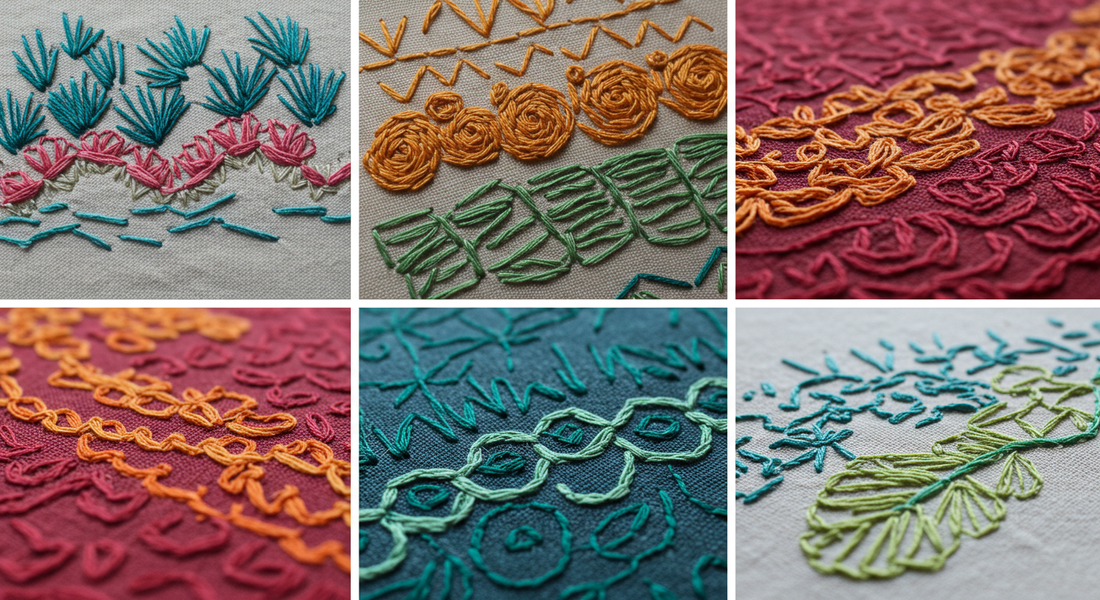
Advanced Stitching Methods
Share
Exploring Intricate Hand Embroidery Techniques for Texture and Elegance
While beginner embroidery relies on foundational stitches like running stitch and backstitch, the true magic of hand embroidery often lies in more intricate techniques. Advanced stitching methods bring dimension, complexity, and artistry to your needlework. In this article, we’ll explore several high-impact stitches—such as chain stitch, feather stitch, bullion knots, and more—and how they can elevate your work from simple to spectacular.

Chain Stitch
What is it?
Chain stitch forms a series of looped stitches that look like a chain. It’s fluid, flexible, and ideal for outlines, curved shapes, and decorative borders.
How to do it:
- Bring the needle up through the fabric.
- Insert it back near the same point, creating a small loop.
- Come up a short distance ahead, catching the loop with the needle.
- Pull the thread through to form the first chain.
- Repeat to build a continuous line.
Variations:
- Detached chain (lazy daisy): Used for petals or small accents.
- Twisted chain: Adds texture with tighter loops.

Feather Stitch
What is it?
Feather stitch creates an open, branching effect, perfect for vines, seaweed, feathers, or decorative borders. It’s especially beautiful in nature-themed work.
How to do it:
- Start at the top and bring the needle up.
- Insert to the side and down slightly, catching the thread in a loose V-shape.
- Alternate sides as you work downward, maintaining symmetry.
Tips:
- Keep your spacing even.
- It looks fantastic in variegated threads.

Bullion Knot
What is it?
The bullion knot is a coiled, raised stitch often used for rose petals, textured flowers, or dimensional centers.
How to do it:
- Bring the needle up through the fabric.
- Insert it a short distance away, but don’t pull it through.
- Wrap the working thread around the needle 5–15 times.
- Carefully pull the needle through the wraps while holding them in place.
- Tug gently to position the knot.
Common Uses:
- Bullion roses
- Curled tendrils or textured accents

Fly Stitch
What is it?
Fly stitch forms an open V shape, useful for leaves, veins, branches, or textured fills.
How to do it:
- Bring the needle up.
- Insert it to the left or right, forming a loose U.
- Come up at the base of the V, catching the thread.
- Anchor the shape with a small vertical stitch.
Use Cases:
- Nature-inspired pieces
- Layered over other stitches for effect

Combining Stitches for Complex Effects
Advanced embroidery often involves combining these stitches:
- Chain + satin = dynamic florals
- Feather + fly = abstract foliage
- Bullion + French knots = dimensional flower centers
You can also vary:
- Thread type (cotton, wool, metallic)
- Thread count (number of strands)
- Direction and layering for movement
Practice Tips
- Use a hoop to maintain fabric tension.
- Start with templates or practice samplers.
- Keep stitch lengths consistent.
- Don’t rush—advanced stitches often need patience.
Final Thoughts
Advanced hand embroidery stitches allow you to create textured, three-dimensional designs that bring your work to life. Whether you're looking to replicate botanicals, craft expressive textures, or simply challenge your skills, mastering techniques like the chain stitch, feather stitch, and bullion knot will transform your embroidery from simple to stunning.